1. The Fridge Is Still Covered in Kid Art from the ’90s
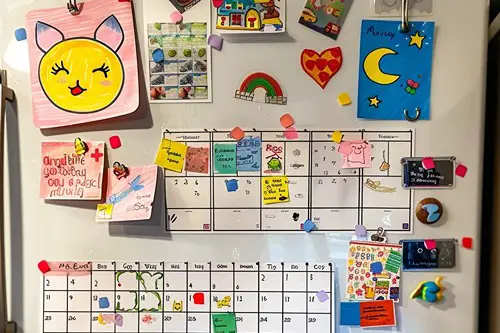
Families who haven’t moved since 1994 often treat the refrigerator like a permanent museum of childhood. That macaroni-covered Mother’s Day card from 1997? Still there, faded and a little crusty, but full of sentimental value. The magnets are the same too—half are souvenirs from gas stations that no longer exist, the others are chipped fruit shapes.
This isn’t just about nostalgia; it’s about identity. The fridge art is a timeline of growing up, and removing it would feel like erasing history. These families haven’t replaced these keepsakes because they don’t need to—nothing’s changed. And that’s kind of the point.
2. One Closet Is Still the “Gift Wrap Station”

Back in the ’90s, it became trendy to designate one closet or cupboard as the go-to place for wrapping supplies. For these unmoved families, that station has remained untouched—same rolls of holiday wrap from 2003, same dull scissors, same crumpled bows. The wrapping paper has yellowed a bit, and there’s at least one “Happy 2000!” gift bag that still gets reused annually.
The tradition continues because it works, and because no one sees a reason to upgrade something that already serves its purpose. Plus, it’s a nostalgic ritual—wrapping gifts with the same snowman paper you used as a kid hits different. Even the smell of that closet brings back memories. It’s efficient, a little quirky, and deeply personal.
3. The Answering Machine Still Says “Leave a Message After the Beep”
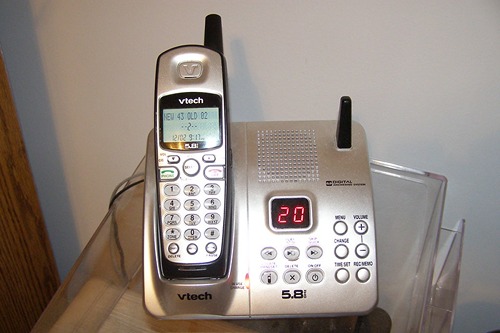
Despite everyone owning smartphones, the landline persists in these households—and so does the old answering machine. The greeting usually features a now-grown child’s voice from second grade saying, “We’re not home right now, please leave a message!” Sometimes it’s unintelligible, sometimes it’s adorable, but it’s always stayed.
The machine has become a kind of time capsule. Re-recording over it feels almost sacrilegious. And oddly enough, the family still checks it—usually once a week, often after it’s already full. They’re not waiting for calls; they’re preserving a sound from the past.
4. The Family Computer Is Still in the “Computer Room”
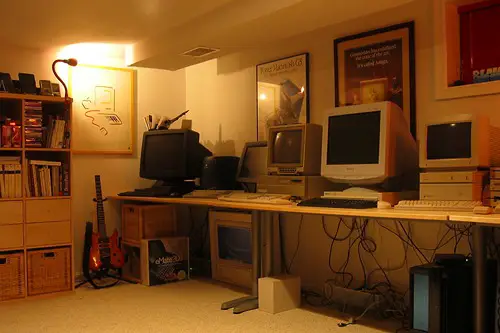
In the mid-’90s, homes often had a dedicated room for the family desktop—usually a Dell with dial-up Internet. Even if the computer’s long gone, the room is still called the “computer room,” and may still have the old desk and wheely chair. The vibe hasn’t changed—there might still be a Rolodex, a paper dictionary, and a stack of AOL CDs.
Even when everyone now uses laptops and tablets in the living room, the idea of having a space just for “online stuff” persists. Sometimes it’s a junk room now, but the identity sticks. It’s a weird domestic label that no one bothers to update. And why would they? Everyone still knows what you mean.
5. There’s a “Good Towels” Rule That No One Questions

These households often still have a secret stash of “good towels” that are only for guests. They’re usually white, untouched, and stored in a high-up linen closet. Meanwhile, the family uses the threadbare ones from the Clinton administration. Some even have embroidered names or the scent of potpourri built in.
This tradition goes back to a time when company meant formality, and appearances mattered. Even though most guests don’t care, the rule is rarely broken. It’s not about logic—it’s about respect for old-school hospitality. And if someone accidentally uses a good towel? It’s a whole thing.
6. The Kitchen Drawer of Dead Electronics Still Exists
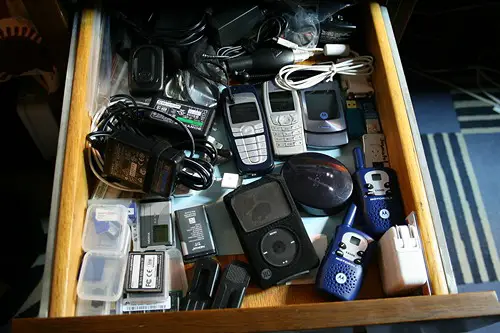
You know the drawer: tangled charger cords for Nokia phones, batteries of unknown age, and an old PalmPilot that no longer turns on. In homes that haven’t moved since the ’90s, this drawer is sacred. It started as a catchall for “tech stuff,” and now it’s a mini landfill of obsolete gadgets. Every household has sworn to clean it one day—just not today.
The idea is, “We might need that someday,” which was a reasonable mindset in the early digital age. But now, even if they know they won’t need a car phone charger, tossing it feels wrong. That drawer holds the digital evolution of the family. And opening it is like peering into a forgotten era.
7. Annual Family Photos Still Happen in the Same Spot

Some families pick one wall, staircase, or fireplace as the sacred photo backdrop. In houses that haven’t moved since 1994, the background stays exactly the same—same paint, same mantle décor, maybe even the same fake plant. The people in the photos grow up, grow out, and grow older, but the scene never shifts. It’s like watching time pass in a time-locked portal.
This tradition works because it makes the photos more powerful. The contrast between the people and the static setting tells its own story. It’s comforting, even when it’s a little bittersweet. And it gives the house a sense of seasonal ritual that newer homes often lack.
8. The Junk Mail Basket Has a Permanent Spot

In these homes, there’s almost always a specific basket or box for junk mail—usually by the door, and always overflowing. It’s filled with catalogs from companies that no longer exist, local newsletters, and coupons that expired a decade ago. Despite the pile growing like a paper-based fungus, no one ever fully empties it. Maybe they’ll sort it someday. Maybe not.
The basket is a remnant of pre-digital info management. Before email inboxes took over, this was how families tracked everything from PTA meetings to supermarket deals. Now, it’s half practical, half decorative, and 100% nostalgic. And no, don’t you dare throw it out.
9. A Wall Still Has Pencil Marks from Kids’ Heights

In the hallway or inside a closet door, there’s a vertical line with names and dates scribbled in pencil. These markings chart each child’s growth spurts, from toddler to teenager. Despite paint touch-ups elsewhere in the house, this section has always been left untouched. The wall might be chipped or scuffed, but it’s sacred ground.
This tradition predates smartphones and photo albums full of date-stamped growth pics. It’s tactile, analog, and emotional. Even long after the kids have moved out, the markings stay as proof that they once lived small here. And yes, new generations get measured right next to the old ones.
10. The Same Christmas Lights Go Up Every Year—Even if Half Don’t Work

The string of multicolored bulbs bought from Kmart in 1996 still comes out each December. There’s always at least one section that won’t light up, and someone inevitably says, “We’ll fix it next year.” But the lights go up anyway, same order, same nails, same gutter hooks. They may look like a fire hazard, but they mean “home.”
This tradition isn’t about showmanship—it’s about consistency. The lights signal the start of the season, regardless of their functionality. Everyone knows what’s missing, and no one minds. It’s part of the charm, like a family joke told for the 20th year in a row.
11. There’s Still a “Phone Book Drawer”

Even though no one’s opened it in a decade, the house still has a drawer with three old phone books, some business cards, and a stack of takeout menus from pre-Internet days. The phone books are yellowed, heavy, and mostly irrelevant. Still, throwing them out feels like losing a backup system. So there they sit, quietly aging.
These homes were built during a time when analog info was security. The phone book drawer was your offline Google. And for some reason, having it intact still feels like a safety net. You never know when the Internet might go down, right?
12. The Thermostat Has an Unspoken Treaty Around It
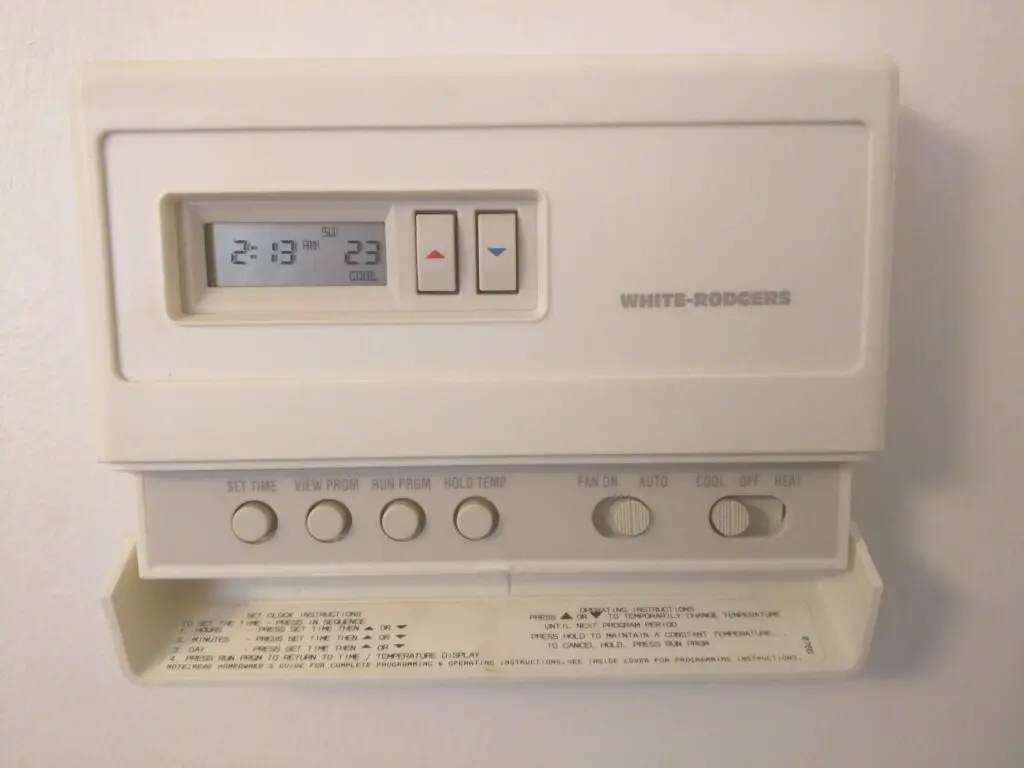
You do not touch the thermostat without permission. In homes that haven’t moved since 1994, there’s often a long-standing, unspoken agreement—parents control the temperature, and everyone else deals with it. There’s even a designated “thermostat dad,” whether he lives there or not. The settings are considered gospel, even if the numbers haven’t changed in years.
The tradition is about more than climate control—it’s about continuity and control. Heating and cooling used to cost more, and habits formed accordingly. The rules never got updated, even if the HVAC system did. And heaven help you if you bump it by mistake.
13. The Couch Has a Permanent Butt Groove—and That’s on Purpose

Over decades of TV watching, newspaper reading, and late-night chats, certain spots on the couch have become molded to specific bodies. In these homes, everyone knows which seat is whose—even guests learn fast. Rearranging cushions or flipping them over is almost taboo. That groove? That’s history.
This isn’t laziness—it’s legacy. The couch becomes a family heirloom of sorts, with every indentation telling a story. People don’t want a new one, because this one fits just right. And if it squeaks or sags a little? All the better.
This post 13 Domestic Traditions That Exist Only in Families Who Haven’t Moved Since 1994 was first published on Greenhouse Black.
